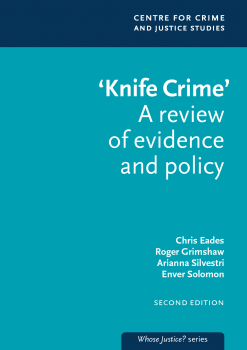'Knife crime'. A review of evidence and policy (2nd Edition)

A coherent evidence based strategy that recognises the deeper structural causes of inequality, poverty and social disaffection is needed to address knife related offending according to a report published by the Centre for Crime and Justice Studies.
The report argues that enforcement and punitive action to tackle knife carrying and knife use, such as harsher sentences, fail to take account of the fact that it is `merely one expression of interpersonal violence'. Success in tackling knife crime will only come with success in dealing with the underlying causes of violence, fear and insecurity.
'Knife Crime' A review of evidence and policy is the second edition of a report originally published in August 2006. It includes the latest official data and a more detailed statistical analysis to determine possible trends in offences involving knives.
The comprehensive review of evidence and policy states that:
- Knife carrying, especially amongst young men, is not unusual but there is insufficient evidence on the extent, nature, motivation, frequency and possible growth of knife carrying. Without further research, designing and implementing programmes to reduce the incidence of knife carrying will be difficult.
- According to official statistics the number of violent crimes involving knives in England and Wales has remained stable in recent years and it is impossible to establish either an upward or down ward trend in the number of actual incidents. Within particular offence categories there is no substantial evidence of a significant change in the proportions of knife use.
- Sharp instruments, which includes knives, are the most common weapon in a homicide. But as a proportion of all homicides the use of sharp instruments has fallen over the past decade, accounting for less than thirty per cent of homicides in 2005/2006 compared to nearly forty percent in 1995.
- There is limited research on the motivations for knife carrying but children who have been a victim of crime are more likely to carry knives. There appears to be a link between knife carrying and whether or not young people feel safe from crime and victimisation.
- The available research shows that children, young people, those living in poor areas and members of black and minority ethnic communities are more likely to be the victims of knife offences.
Roger Grimshaw, Research Director at the Centre for Crime and Justice Studies said:
Because knives are a part of everyone's lifestyle, their role in offending tells us something about the tensions and fears in society. The available evidence about knife use in offending shows it to be a stubborn problem that requires more attention to the causes of conflict, instead of frantic law-making.'
Richard Garside, Director of the Centre for Crime and Justice Studies, added:
'The government may be sincere in its wish to tackle knife-related crime and violence. Yet current policy is bedevilled by a lack of good quality of data on incidents and trends, which contributes to a lack of clear thinking about what might be truly effective.'